Transient Electromagnetic (TEM) Surveys as a First Approach for Characterizing a Regional Aquifer: The Case of the Saint-Narcisse Moraine, Quebec, Canada
Abstract
1. Introduction
2. Study Area and Geological Overview
2.1. Basement Geology
2.2. Quaternary Sediment Deposits
Saint-Narcisse Moraine
3. Materials and Methods
3.1. TEM Field Setup
3.2. TEM Data Inversion
3.3. TEM Calibration
3.3.1. Stratigraphic Calibration
3.3.2. Groundwater Piezometric Map and the Saturated/Unsaturated Sediment Resistivity Chart
4. Results
4.1. Groundwater Piezometric Map
4.2. TEM Calibration
4.3. Compilation and Calibration Chart
4.4. TEM Results
4.4.1. Western Sector (Notre-Dame-du-Mont-Carmel)
4.4.2. Central Sector (Saint-Narcisse)
5. Discussion
5.1. Sedimentary Facies Resistivity
5.2. Relationship between the Calibration Chart and the TEM Sections
5.3. Hydrogeological Exploration Targets
5.3.1. Western Sector (Notre-Dame-du-Mont-Carmel)
5.3.2. Central Sector (Saint-Narcisse)
5.3.3. Compartmentalization of the Aquifers
6. Conclusions
Supplementary Materials
Author Contributions
Funding
Institutional Review Board Statement
Informed Consent Statement
Data Availability Statement
Acknowledgments
Conflicts of Interest
References
- Parriaux, A.; Nicoud, G. De la montagne à la mer, les formations glaciaires et l’eau souterraine. Exemple du contexte Nord-alpin occidental. Quaternaire 1993, 4, 61–67. [Google Scholar] [CrossRef]
- Burt, A.K. Three-dimensional hydrostratigraphy of the Orangeville Moraine area, southwestern Ontario, Canada. Can. J. Earth Sci. 2018, 55, 802–828. [Google Scholar] [CrossRef]
- Sass, O. Determination of the internal structure of alpine talus deposits using different geophysical methods (Lechtaler Alps, Austria). Geomorphology 2006, 80, 45–58. [Google Scholar] [CrossRef]
- McClymont, A.F.; Hayashi, M.; Bentley, L.R.; Muir, D.; Ernst, E. Groundwater flow and storage within an alpine meadow-talus complex. Hydrol. Earth Syst. Sci. 2010, 14, 859–872. [Google Scholar] [CrossRef]
- Schrott, L.; Hufschmidt, G.; Hankammer, M.; Hoffmann, T.; Dikau, R. Spatial distribution of sediment storage types and quantification of valley fill deposits in an alpine basin, Reintal, Bavarian Alps, Germany. Geomorphology 2003, 55, 45–63. [Google Scholar] [CrossRef]
- Daigneault, R.-A.; Occhietti, S. Les moraines du massif Algonquin, Ontario, au début du Dryas récent, et corrélation avec la Moraine de Saint-Narcisse. Géographie Phys. Quat. 2006, 60, 103–118. [Google Scholar] [CrossRef][Green Version]
- Occhietti, S. The Saint-Narcisse morainic complex and early Younger Dryas events on the southeastern margin of the Laurentide Ice Sheet. Géographie Phys. Quat. 2007, 61, 89–117. [Google Scholar] [CrossRef]
- Occhietti, S.; Chartier, H.M.; Hillaire-Marcel, C.; Cournoyer, M.; Cumbaa, S.L.; Harington, R. Paléoenvironnements de la mer de Champlain dans la région de Québec, entre 11 300 et 9750 bp: Le site de Saint-Nicolas. Géographie Phys. Quat. 2001, 55, 23–46. [Google Scholar] [CrossRef]
- Occhietti, S. Stratigraphie du Wisconsinien de la région de Trois-Rivières-Shawinigan, Québec. Géographie Phys. Quat. 1977, 31, 307–322. [Google Scholar] [CrossRef]
- Girard, F. Architecture et Hydrostratigraphie d’un Complexe Morainique et Deltaïque dans la Région de Saint-Raymond de Portneuf, Québec. Ph.D. Thesis, Université du Québec, Institut National de la Recherche Scientifique, Quebec, QC, Canada, 2001. [Google Scholar]
- Légaré-Couture, G.; Leblanc, Y.; Parent, M.; Lacasse, K.; Campeau, S. Three-dimensional hydrostratigraphical modelling of the regional aquifer system of the St. Maurice Delta Complex (St. Lawrence Lowlands, Canada). Can. Water Resour. J./Rev. Can. Ressour. Hydr. 2017, 43, 92–112. [Google Scholar] [CrossRef]
- Palacky, G. Resistivity characteristics of geological targets. In Electromagnetic Methods in Applied Geophysics; Nabighian, M., Ed.; Society of Exploration Geophysicists: Tulsa, OK, USA, 1987; pp. 55–129. [Google Scholar]
- Palacky, G. Use of airborne electromagnetic methods for resource mapping. Adv. Space Res. 1993, 13, 5–14. [Google Scholar] [CrossRef]
- Sørensen, K.I.; Auken, E.; Thomsen, P. TDEM in Groundwater Mapping–A Continuous Approach. In Proceedings of the Symposium on the Application of Geophysics to Engineering and Environmental Problems 2000, Arlington, VA, USA, 20–24 February 2000. [Google Scholar]
- Danielsen, J.E.; Auken, E.; Jørgensen, F.; Søndergaard, V.; Sørensen, K.I. The application of the transient electromagnetic method in hydrogeophysical surveys. J. Appl. Geophys. 2003, 53, 181–198. [Google Scholar] [CrossRef]
- Reynolds, J.M. An Introduction to Applied and Environmental Geophysics, 2nd ed.; John Wiley & Sons: Hoboken, NJ, USA, 2011; ISBN 1119957141. [Google Scholar]
- Goldman, M.; Kafri, U. Geoelectric, Geoelectromagnetic and Combined Geophysical Methods in Groundwater Exploration in Israel. In The Many Facets of Israel’s Hydrogeology; Springer: Berlin/Heidelberg, Germany, 2020; pp. 299–393. [Google Scholar]
- Larocque, M.; Meyzonnat, G.; Ouellet, M.-A.; Graveline, M.-H.; Gagné, S.; Barnetche, D.; Dorner, S. Projet de Connaissance des Eaux Souterraines de la Zone Vaudreuil-Soulanges. Rapport Synthese; Université du Québec à Montréal: Montréal, QC, Canada, 2015. [Google Scholar]
- Chesnaux, R.; Lambert, M.; Walter, J.; Fillastre, U.; Hay, M.; Rouleau, A.; Daigneault, R.; Moisan, A.; Germaneau, D. Building a geodatabase for mapping hydrogeological features and 3D modeling of groundwater systems: Application to the Saguenay–Lac-St.-Jean region, Canada. Comput. Geosci. 2011, 37, 1870–1882. [Google Scholar] [CrossRef]
- Walter, J.; Rouleau, A.; Chesnaux, R.; Lambert, M.; Daigneault, R. Characterization of general and singular features of major aquifer systems in the Saguenay-Lac-Saint-Jean region. Can. Water Resour. J./Rev. Can. Ressour. Hydr. 2017, 43, 75–91. [Google Scholar] [CrossRef]
- Douglas, R.J.W.; Poole, W.H.; Sanford, B.V.; Williams, H.; Kelly, D.G. Geology and Economic minerals of Canada. In Geology and Economic Minerals of Canada; Geological Survey of Canada: Ottawa, ON, Canada, 1970; Volume 1, pp. 649–662. [Google Scholar]
- Globensky, Y. Géologie des Basses-Terres du Saint-Laurent; Ministère de L’énergie et des Ressources: Québec, QC, Canada, 1987. [Google Scholar]
- Rivers, T.; Van Gool, J.; Connelly, J.N. Contrasting tectonic styles in the northern Grenville province: Implications for the dynamics of orogenic fronts. Geology 1993, 21, 1127–1130. [Google Scholar] [CrossRef]
- Nadeau, L.; Brouillette, P. Carte structurale de la région de Shawinigan (SNRC 31I), Province de Grenville, Québec. Comm. Géologique Canada Doss. Public 1995. [Google Scholar] [CrossRef]
- Parent, M.; Occhietti, S. Late Wisconsinan deglaciation and glacial lake development in the Appalachians of southeastern Québec. Géographie Phys. Quat. 1999, 53, 117–135. [Google Scholar] [CrossRef]
- Parent, M.; Occhietti, S. Late Wisconsinan Deglaciation and Champlain Sea Invasion in the St. Lawrence Valley, Québec. Géographie Phys. Quat. 1988, 42, 215–246. [Google Scholar] [CrossRef]
- Dyke, A.S.; Prest, V.K. Late Wisconsinan and Holocene History of the Laurentide Ice Sheet*. Géographie Phys. Quat. 1987, 41, 237–263. [Google Scholar] [CrossRef]
- Dietrich, J.; Bunya, S.; Westerink, J.J.; Ebersole, B.A.; Smith, J.M.; Atkinson, J.H.; Jensen, R.; Resio, D.T.; Luettich, R.A.; Dawson, C.; et al. A High-Resolution Coupled Riverine Flow, Tide, Wind, Wind Wave, and Storm Surge Model for Southern Louisiana and Mississippi. Part II: Synoptic Description and Analysis of Hurricanes Katrina and Rita. Mon. Weather. Rev. 2010, 138, 378–404. [Google Scholar] [CrossRef]
- Margold, M.; Stokes, C.; Clark, C.D. Ice streams in the Laurentide Ice Sheet: Identification, characteristics and comparison to modern ice sheets. Earth-Sci. Rev. 2015, 143, 117–146. [Google Scholar] [CrossRef]
- Stokes, C. Deglaciation of the Laurentide Ice Sheet from the Last Glacial Maximum. Geogr. Res. Lett. 2017, 43, 377. [Google Scholar] [CrossRef]
- Lévesque, Y.; St-Onge, G.; Lajeunesse, P.; Desiage, P.; Brouard, E. Defining the maximum extent of the Laurentide Ice Sheet in Home Bay (eastern Arctic Canada) during the Last Glacial episode. Boreas 2019, 49, 52–70. [Google Scholar] [CrossRef]
- Benn, D.; Evans, D.J.A. Glaciers and Glaciation, 1st ed.; Routledge: London, UK; New York, NY, USA, 2014; ISBN 1444128396. [Google Scholar]
- Evans, D. Glacial Landsystems, 1st ed.; Routledge: London, UK; New York, NY, USA, 2014; ISBN 1444119168. [Google Scholar]
- Landry, B.; Beaulieu, J.; Gauthier, M.; Lucotte, M.; Moingt, S.; Occhietti, S.; Pinti, D.L.; Quirion, M. Notions de Géologie, 4th ed.; Modulo: Montréal, QC, Canada, 2012; ISBN 2-89113-256-4. [Google Scholar]
- Tricart, J.; Occhietti, S. Le Quaternaire de la région de Trois-Rivières-Shawinigan, Québec. Contribution à la paléogéographie de la vallée moyenne du St-Laurent et corrélations stratigraphiques. In Annales de Géographie; Armand Colin: Paris, France, 1983; Volume 92, pp. 242–245. [Google Scholar]
- Nabighian, M.N. Electromagnetic Methods in Applied Geophysics; Society of Exploration Geophysicists: Tulsa, OK, USA, 1991; Volume 2. [Google Scholar]
- Fitterman, D.V.; Labson, V.F. Electromagnetic Induction Methods for Environmental Problems. In Near-Surface Geophysiscs; Society of Exploration Geophysicists: Tulsa, OK, USA, 2005; pp. 301–356. [Google Scholar]
- Fitterman, D.V.; Stewart, M.T. Transient electromagnetic sounding for groundwater. Geophysics 1986, 51, 995–1005. [Google Scholar] [CrossRef]
- Parsekian, A.; Singha, K.; Minsley, B.; Holbrook, W.S.; Slater, L. Multiscale geophysical imaging of the critical zone. Rev. Geophys. 2014, 53, 1–26. [Google Scholar] [CrossRef]
- Kafri, U.; Goldman, M.; Lang, B. Detection of subsurface brines, freshwater bodies and the interface configuration in-between by the time domain electromagnetic method in the Dead Sea Rift, Israel. Environ. Earth Sci. 1997, 31, 42–49. [Google Scholar] [CrossRef]
- Kalisperi, D.; Kouli, M.; Vallianatos, F.; Soupios, P.; Kershaw, S.; Lydakis-Simantiris, N. A Transient ElectroMagnetic (TEM) Method Survey in North-Central Coast of Crete, Greece: Evidence of Seawater Intrusion. Geosciences 2018, 8, 107. [Google Scholar] [CrossRef]
- MacInnes, S.; Raymond, M. Zonge Data Processing Two-Dimensional, Smooth-Model CSAMT Inversion version 3.00; Zonge Engineering and Research Organization, Inc.: Edwardstown, Australia, 2001; p. 41. [Google Scholar]
- MacInnes, S.; Raymond, M. STEMINV: Smooth Model TEM Inversion. Zo. Eng. Tucson, AZ. 2005. Available online: http://zonge.com/instruments-home/software/modeling-tem/ (accessed on 17 August 2021).
- Constable, S.; Parker, R.L.; Constable, C. Occam’s inversion: A practical algorithm for generating smooth models from electromagnetic sounding data. Geophysics 1987, 52, 289–300. [Google Scholar] [CrossRef]
- Dewar, N.; Knight, R. Estimation of the top of the saturated zone from airborne electromagnetic data. Geophysics 2020, 85, EN63–EN76. [Google Scholar] [CrossRef]
- McCormack, R. Etude hydrogéologique de la rive nord du Saint-Laurent. In Énergie et Ressource Naturelle; Service des Eaux Souterraines: Québec, QC, Canada, 1983; Volume 15, p. 188. ISBN 2550029399. [Google Scholar]
- Zimmerman, D.; Pavlik, C.; Ruggles, A.; Armstrong, M. An Experimental Comparison of Ordinary and Universal Kriging and Inverse Distance Weighting. Math. Geol. 1999, 31, 375–390. [Google Scholar] [CrossRef]
- Jones, N.L.; Davis, R.J.; Sabbah, W. A comparison of three-dimensional interpolation techniques for plume characterization. Ground Water 2003, 41, 411–419. [Google Scholar] [CrossRef]
- Wise, S. Assessing the quality for hydrological applications of digital elevation models derived from contours. Hydrol. Process. 2000, 14, 1909–1929. [Google Scholar] [CrossRef]
- Abu-Hassanein, Z.S.; Benson, C.H.; Blotz, L.R. Electrical Resistivity of Compacted Clays. J. Geotech. Eng. 1996, 122, 397–406. [Google Scholar] [CrossRef]
- Shukla, S.K.; Yin, J.-H. Fundamentals of Geosynthetic Engineering, 1st ed.; Taylor and Francis, Balkema: London, UK, 2006; ISBN 1482288443. [Google Scholar]
- Pandey, L.M.; Shukla, S.K.; Habibi, D. Electrical resistivity of sandy soil. Geotech. Lett. 2015, 5, 178–185. [Google Scholar] [CrossRef]
- McCarter, W.J. The electrical resistivity characteristics of compacted clays. Geotechnique 1984, 34, 263–267. [Google Scholar] [CrossRef]
- Kemna, A.; Binley, A.; Slater, L. Crosshole IP imaging for engineering and environmental applications. Geophysics 2004, 69, 97–107. [Google Scholar] [CrossRef]
- Ferland, P.; Occhietti, S. Révision du stratotype des Sédiments de Saint-Pierre et implications stratigraphiques, vallée du Saint-Laurent, Québec. Géographie Phys. Quat. 1990, 44, 147–158. [Google Scholar] [CrossRef][Green Version]
- Grenier, C.; Denis, R. Etude hydrogeomorphologique dans la region du Lac Maskinongé, Québec. Can. J. Earth Sci. 1974, 11, 733–754. [Google Scholar] [CrossRef]
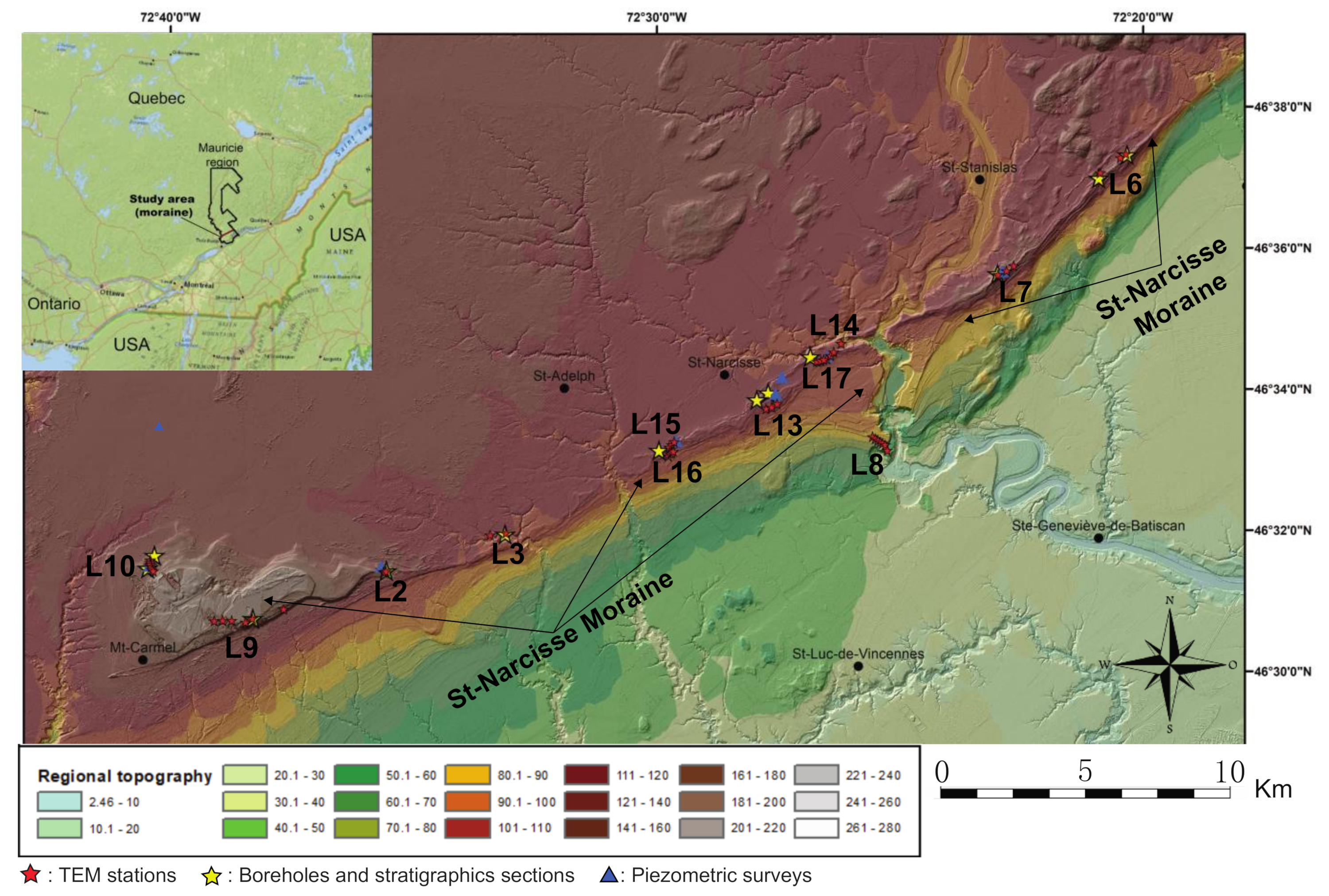

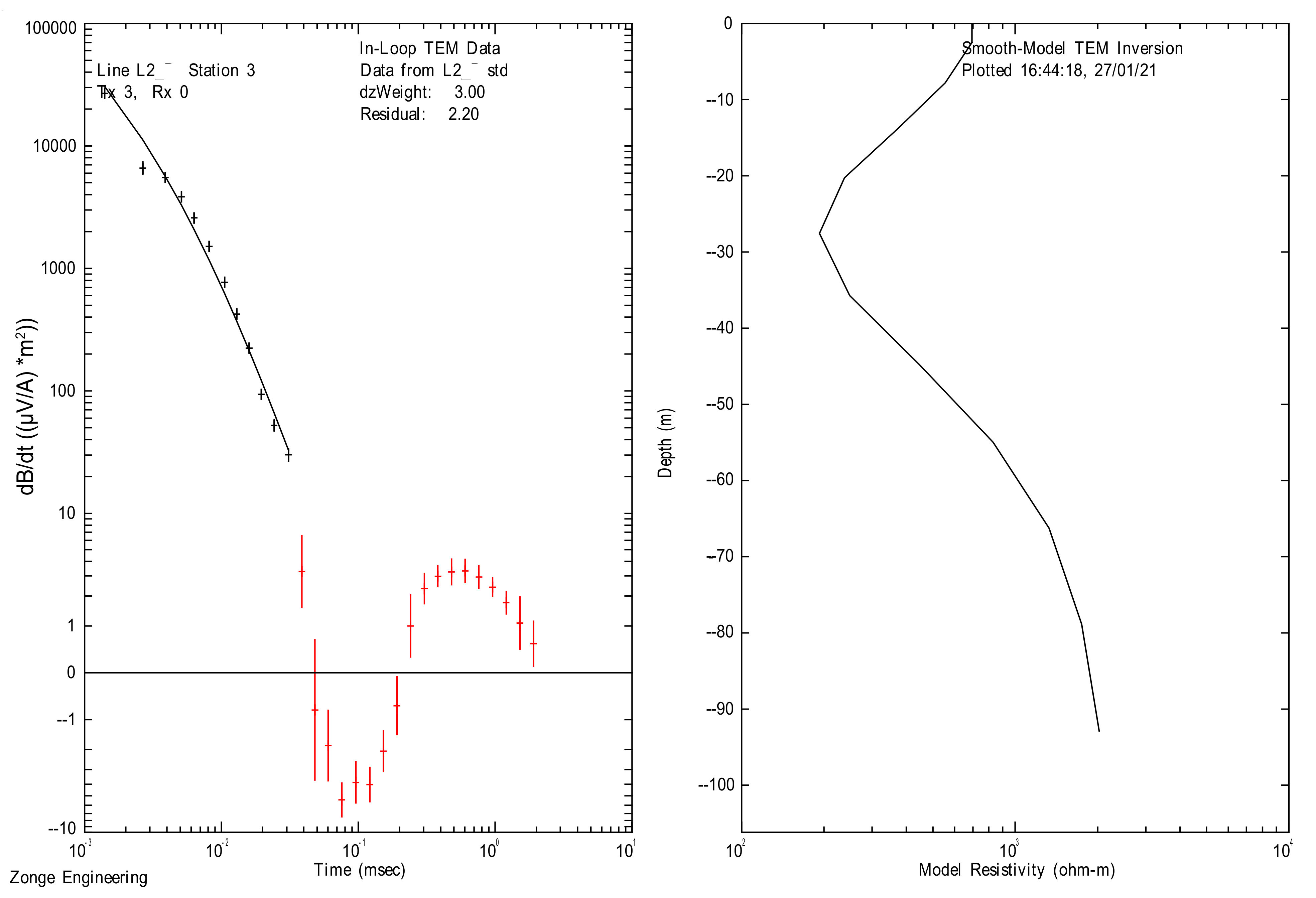
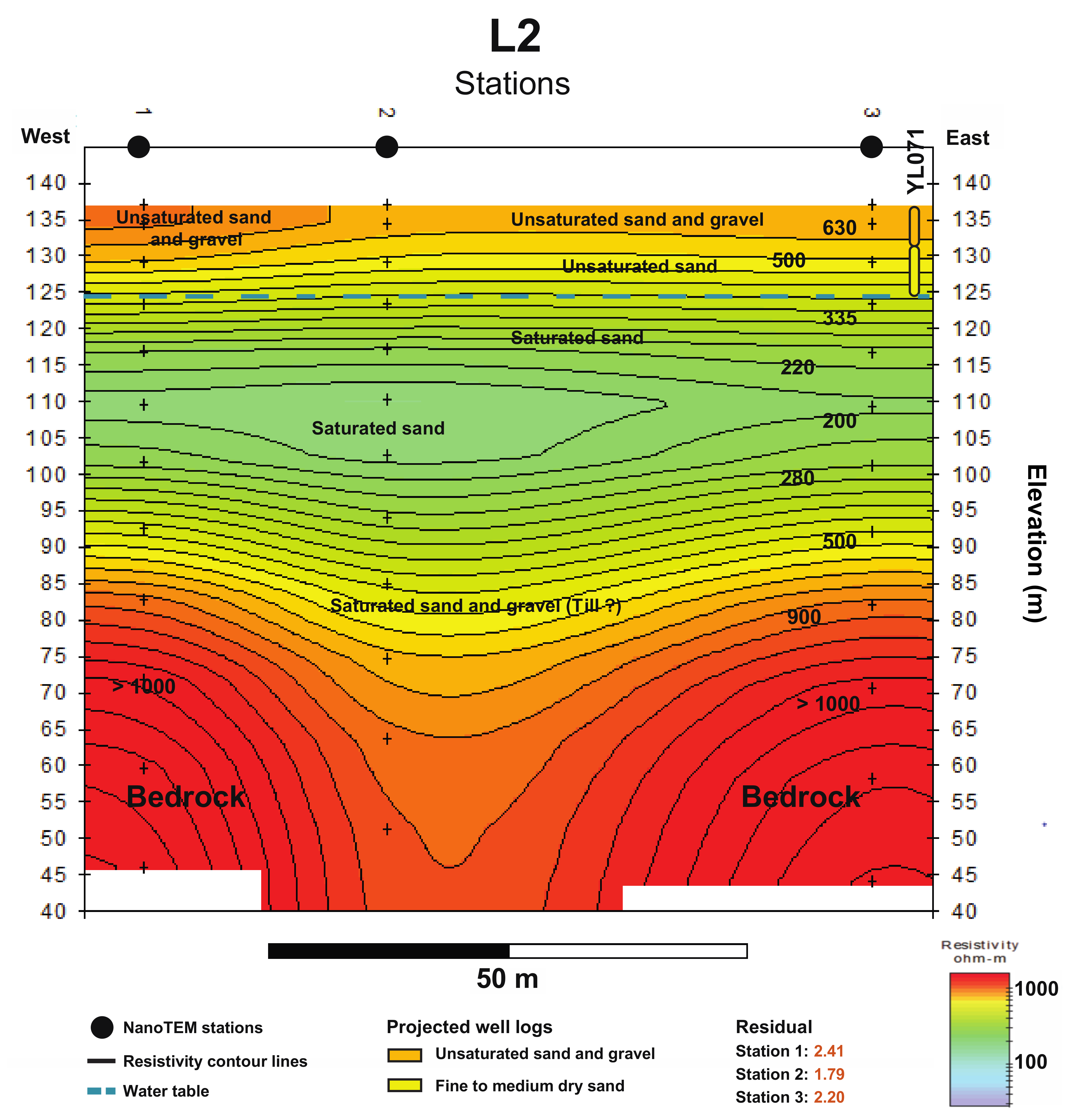
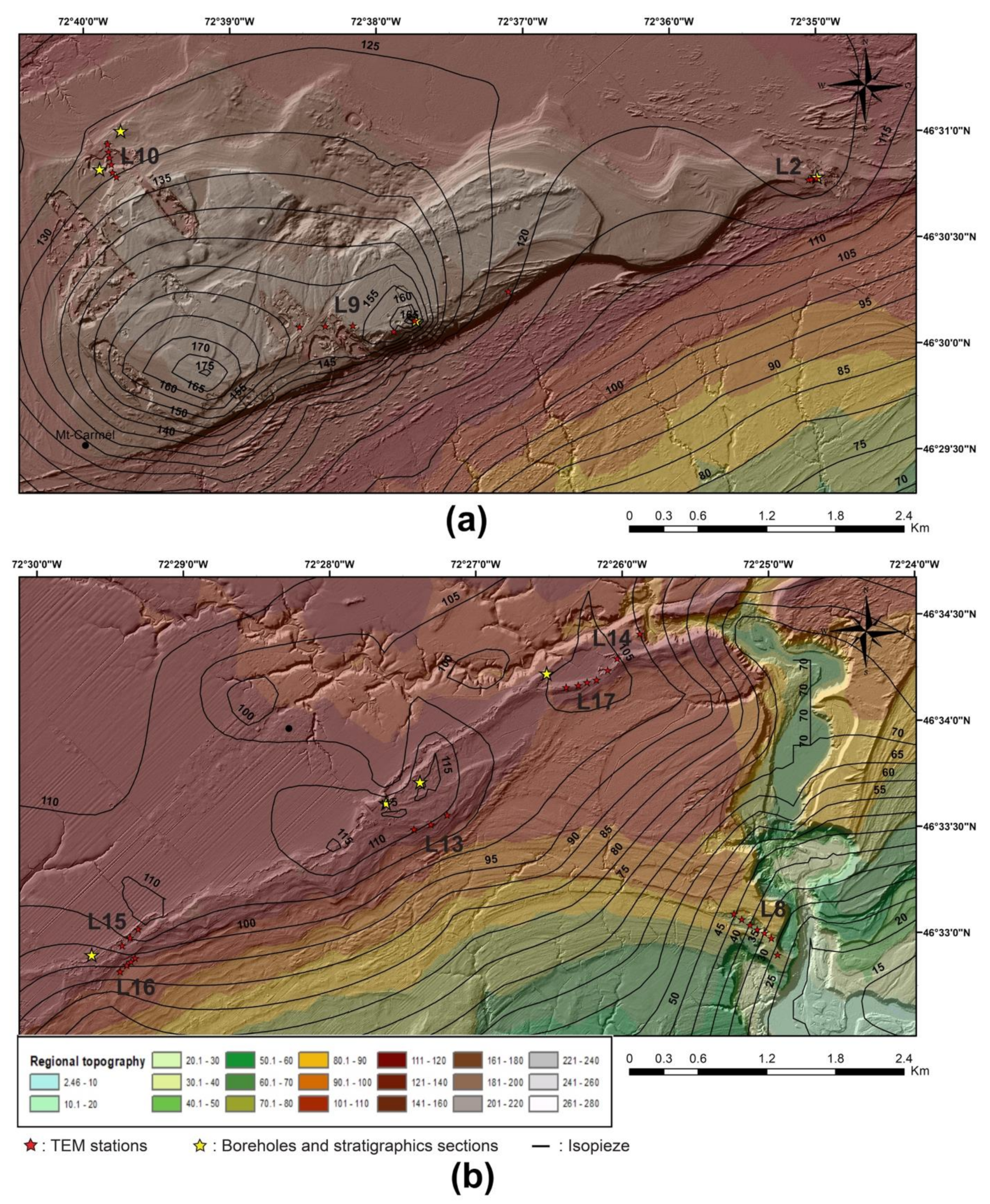


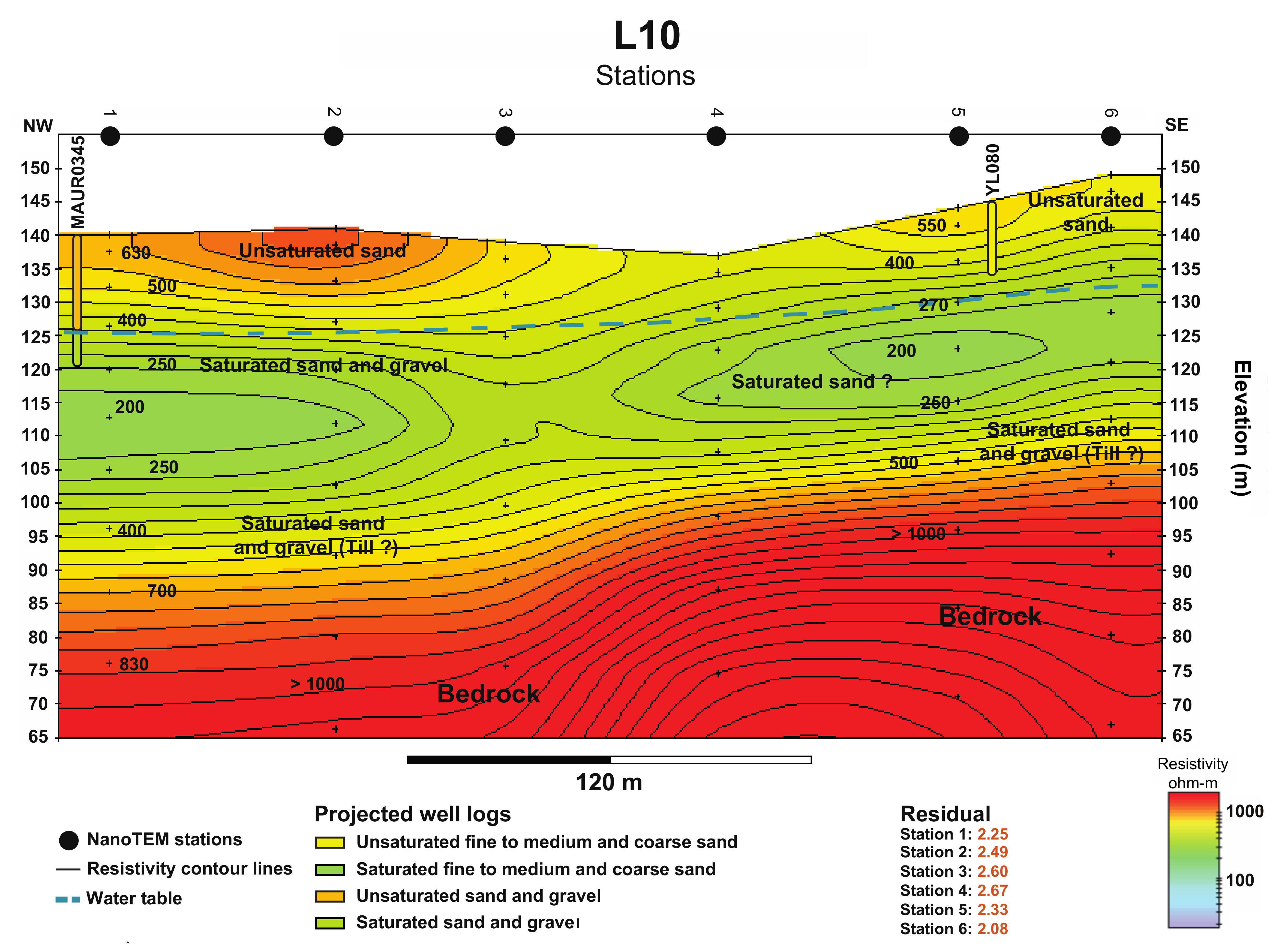


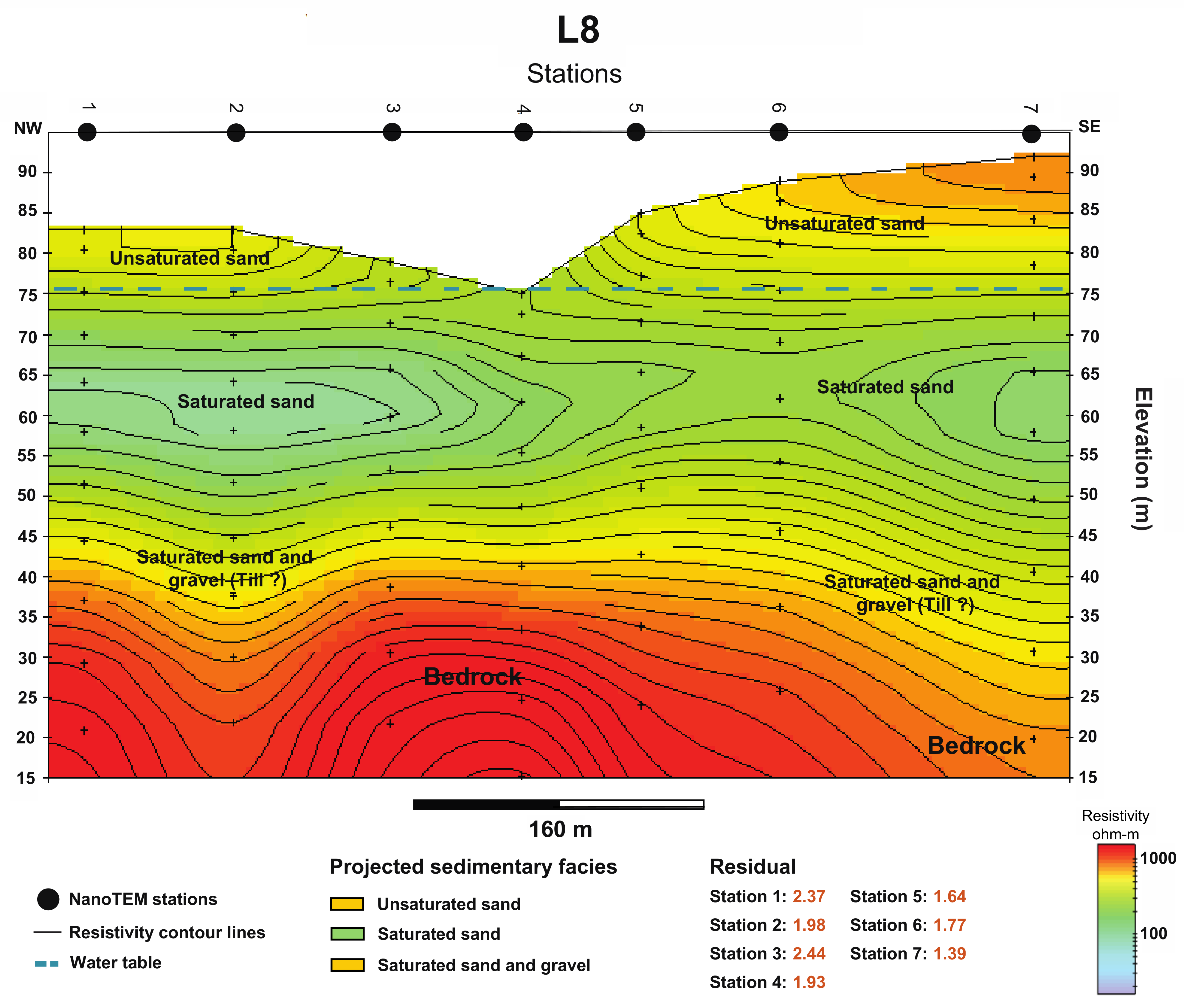
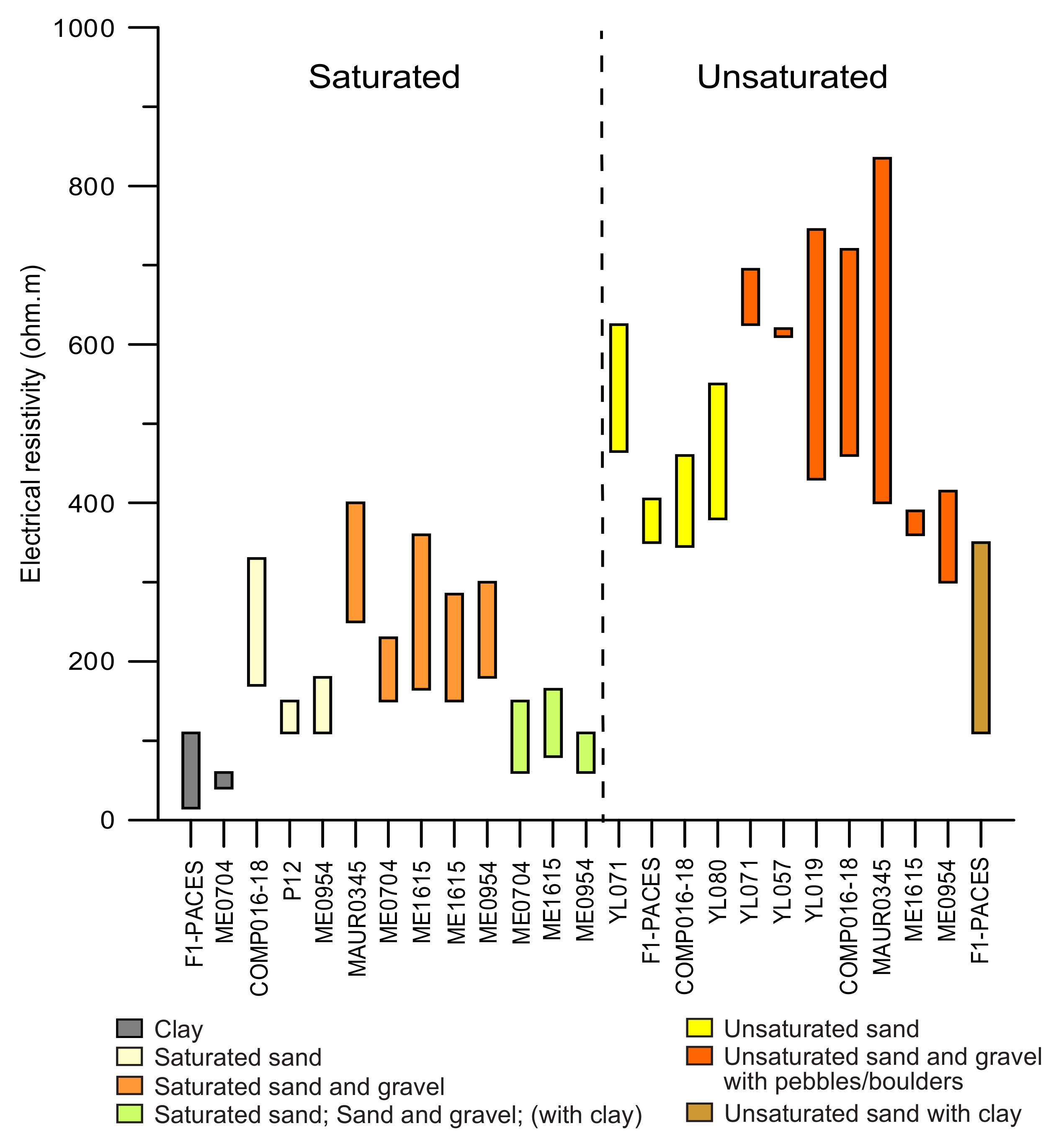
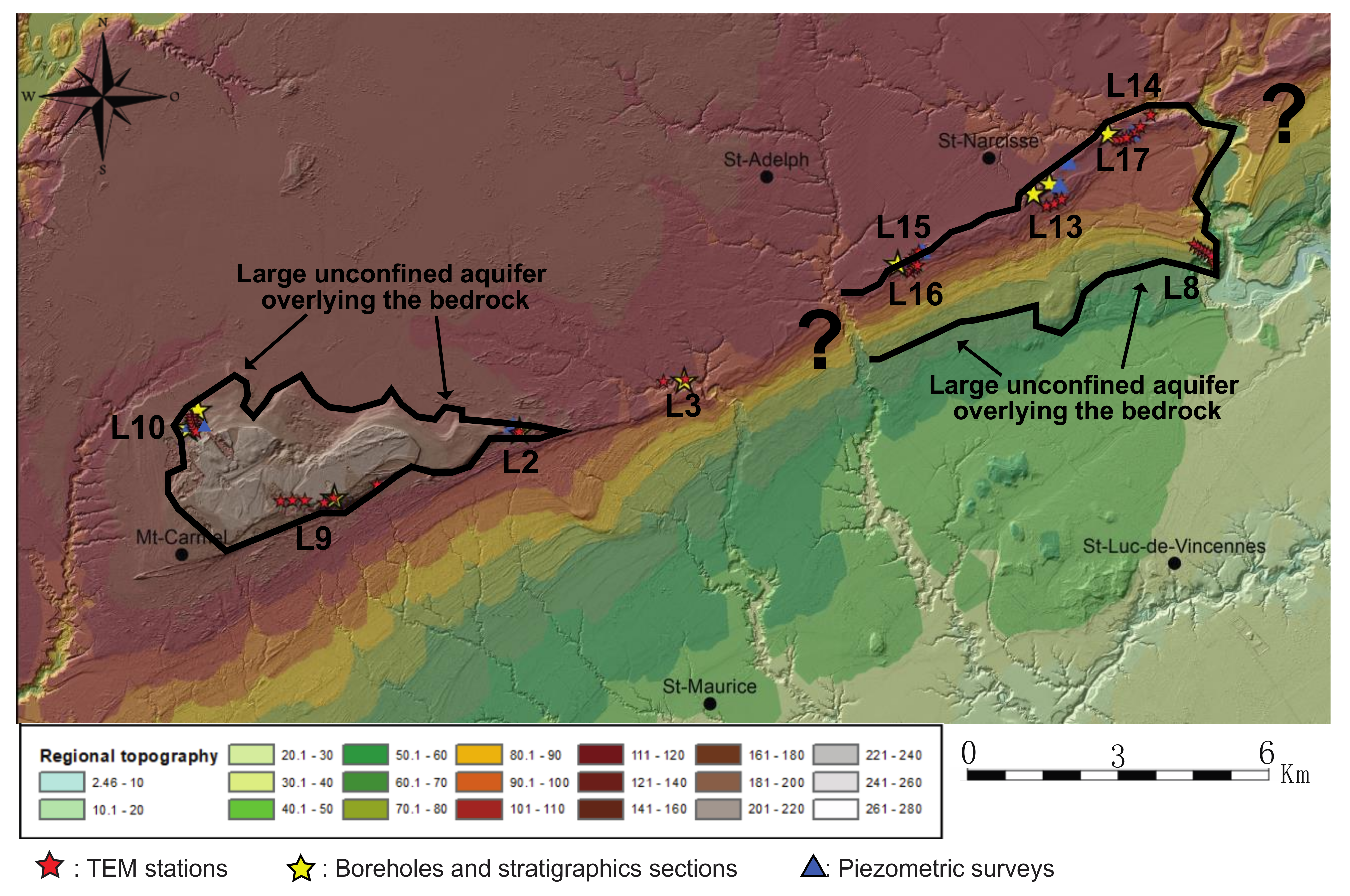
| Sediment Class (Unsaturated and Saturated) | Electrical Resistivity (ohm.m) |
|---|---|
| Unsaturated sand | 345–650 |
| Saturated sand | 110–330 |
| Unsaturated sand and gravel with pebbles/boulders | 370–835 |
| Saturated sand and gravel | 150–400 |
| Unsaturated sand with clay | 110–350 |
| Saturated sand; Sand and gravel; (with clay) | 60–165 |
| Clay | <110 |
| Bedrock | >1000 |
Publisher’s Note: MDPI stays neutral with regard to jurisdictional claims in published maps and institutional affiliations. |
© 2021 by the authors. Licensee MDPI, Basel, Switzerland. This article is an open access article distributed under the terms and conditions of the Creative Commons Attribution (CC BY) license (https://creativecommons.org/licenses/by/4.0/).
Share and Cite
Lévesque, Y.; Walter, J.; Chesnaux, R. Transient Electromagnetic (TEM) Surveys as a First Approach for Characterizing a Regional Aquifer: The Case of the Saint-Narcisse Moraine, Quebec, Canada. Geosciences 2021, 11, 415. https://doi.org/10.3390/geosciences11100415
Lévesque Y, Walter J, Chesnaux R. Transient Electromagnetic (TEM) Surveys as a First Approach for Characterizing a Regional Aquifer: The Case of the Saint-Narcisse Moraine, Quebec, Canada. Geosciences. 2021; 11(10):415. https://doi.org/10.3390/geosciences11100415
Chicago/Turabian StyleLévesque, Yan, Julien Walter, and Romain Chesnaux. 2021. "Transient Electromagnetic (TEM) Surveys as a First Approach for Characterizing a Regional Aquifer: The Case of the Saint-Narcisse Moraine, Quebec, Canada" Geosciences 11, no. 10: 415. https://doi.org/10.3390/geosciences11100415
APA StyleLévesque, Y., Walter, J., & Chesnaux, R. (2021). Transient Electromagnetic (TEM) Surveys as a First Approach for Characterizing a Regional Aquifer: The Case of the Saint-Narcisse Moraine, Quebec, Canada. Geosciences, 11(10), 415. https://doi.org/10.3390/geosciences11100415






